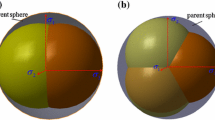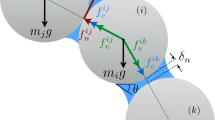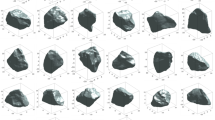Abstract
Viscocohesive–frictional particle agglomerates such as cohesive powder mixtures, clusters of cemented granular materials, and iron-ores are commonly found in civil engineering and industries. The compressive and tensile properties of these agglomerates commonly reveal complex behavior, but our understanding of their mechanical strengths is still limited. In this paper, we numerically explore the diametrical compression test of viscocohesive–frictional particle agglomerates by means of the discrete element method, where the system composes of primary spherical particles and systematically varying different values of the cohesive and viscous stress between grains. We impose different compressive downward velocities which apply on the top platen, whereas the bottom platen is immobilized, leading to different compressive and tensile responses of such agglomerates. Based on the previous definition of the dimensionless impact parameter of agglomerates impacting on a rigid plane (Vo in Phys. Rev. E 103:042902), which helps to get a unified description of both compressive and tensile strengths of viscocohesive–frictional particle agglomerates under diametrical compression test by the same quadratic increasing function form. This unified controlling can be well explained due to the unified representation of the densities, intensities, and orientations of the normal forces between grains, leading to robustly providing physical insights into the mechanical strength of agglomerates presented in civil engineering and industries.









Similar content being viewed by others
References
Affes R, Delenne J-Y, Monerie Y, Radjai F, Topin V (2012) Tensile strength and fracture of cemented granular aggregates. Eur Phys J E 35:117
Shen Z, Huang D, Wang G, Zhao Y, Jin F (2022) A mesoscale bond model for discrete element modeling of irregular cemented granular materials. Comput Geotech 152:105051
Tengattini A, Nguyen GD, Viggiani G, Einav I. Micromechanically inspired investigation of cemented granular materials: part II—from experiments to modelling and back. Acta Geotechnica
Nguyen T-K, Desrues J, Vo T-T, Combe G (2022) FEM x DEM multi-scale model for cemented granular materials: inter-and intra-granular cracking induced strain localisation. Int J Numer Anal Meth Geomech 46(5):1001–1025
Iveson SM, Holt S, Biggs S (2000) Contact angle measurements of iron ore powders. Colloids Surf A 166(1):203–214
Iveson S, Holt S, Biggs S (2004) Advancing contact angle of iron ores as a function of their hematite and goethite content: implications for pelletising and sintering. Int J Miner Process 74(1):281–287
Zhu D, Pan J, Lu L, Holmes R (2015) 15—Iron ore pelletization. In: Lu L (ed) Iron Ore. Woodhead Publishing, pp 435–473
Wang D, Servin M, Berglund T, Mickelsson K-O, Rönnbäck S (2015) Parametrization and validation of a nonsmooth discrete element method for simulating flows of iron ore green pellets. Powder Technol 283:475–487
Contreras RJ, van Loo F, Douce J, Evrard M, Pirard E (2015) Advanced characterisation to investigate the effect of raw material properties on the kinetics of iron ores granulation. In: ESTAD conference, vol 288, pp 249–254
Wu C-Y, Best SM, Bentham AC, Hancock BC, Bonfield W (2005) A simple predictive model for the tensile strength of binary tablets. Eur J Pharm Sci 25(2):331–336
Rondet E, Delalonde M, Ruiz T, Desfours JP (2009) Identification of granular compactness during the kneading of a humidified cohesive powder. Powder Technol 191(1–2):7–12
Tsoungui O, Vallet D, Charmet J-C (1999) Numerical model of crushing of grains inside two-dimensional granular materials. Powder Technol 105(1):190–198
Vo T-T (2021) Scaling behavior of the tensile strength of viscocohesive granular aggregates. Phys Rev E 103:042902
Azéma E, Sánchez P, Scheeres DJ (2018) Scaling behavior of cohesive self-gravitating aggregates. Phys Rev E 98:030901
Vo T-T, Mutabaruka P, Nezamabadi S, Delenne J-Y, Izard E, Pellenq R, Radjai F (2018) Mechanical strength of wet particle agglomerates. Mech Res Commun 92:1–7
Tatsuuma M, Kataoka A, Tanaka H (2019) Tensile strength of porous dust aggregates. Astrophys J 874(2):159
Horabik J, Wiacek J, Parafiniuk P, Stasiak M, Banda M, Molenda M (2019) Tensile strength of pressure-agglomerated potato starch determined via diametral compression test: discrete element method simulations and experiments. Biosys Eng 183:95–109
Xiao H, Ivancic RJS, Durian DJ (2020) Strain localization and failure of disordered particle rafts with tunable ductility during tensile deformation. Soft Matter 16:8226–8236
Frank X, Radjaï F, Nezamabadi S, Delenne J-Y (2020) Tensile strength of granular aggregates: Stress chains across particle phase versus stress concentration by pores. Phys Rev E 102:022906
Vo T-T, Nguyen T-K (2022) The roles of the reversibility and irreversibility of capillary bonds on the impact dynamics of agglomerates. Acta Geotech 18:217–233
Iveson S, Beathe J, Page N (2002) The dynamic strength of partially saturated powder compacts: the effect of liquid properties. Powder Technol 127:149–161
Thornton C, Ciomocos MT, Adams MJ (2004) Numerical simulations of diametrical compression tests on agglomerates. Powder Technol 140:258–267
Fu J, Reynolds GK, Adams MJ, Hounslow MJ, Salman AD (2005) An experimental study of the impact breakage of wet granules. Chem Eng Sci 60(14):4005–4018
Cantor D, Azéma E, Sornay P, Radjai F (2016) Three-dimensional bonded-cell model for grain fragmentation. Comput Part Mech 1–10 (2016)
Wang W, Pan J, Jin F (2019) Mechanical behavior of cemented granular aggregates under uniaxial compression. J Mater Civ Eng 31(5):04019047
Vo T-T, Nezamabadi S, Mutabaruka P, Delenne J-Y, Radjai F (2020) Additive rheology of complex granular flows. Nat Commun 11:1476
Mutabaruka P (2013) Numerical modeling of immersed granular media: initiation and propagation of avalanches in a fluid. Ph.D. thesis, Ph. D. thesis, Université de Montpellier
Cundall PA, Strack ODL (1979) A discrete numerical model for granular assemblies. Géotechnique 29(1):47–65
Herrmann HJ, Luding S (1998) Modeling granular media with the computer. Continuum Mech Thermodyn 10:189–231
Thornton C (1999) Quasi-static shear deformation of a soft particle system. Powder Technol 109:179–191
Radjai F, Dubois F (2011) Discrete-element modeling of granular materials. Wiley-Iste
Delenne J-Y, El Youssoufi MS, Cherblanc F, Bénet J-C (2004) Mechanical behaviour and failure of cohesive granular materials. Int J Numer Anal Meth Geomech 28(15):1577–1594
Richefeu V, Radjai F, Youssoufi MSE (2007) Stress transmission in wet granular materials. Eur Phys J E 21:359–369
Scholtés L, Donzè F-V (2013) A dem model for soft and hard rocks: role of grain interlocking on strength. J Mech Phys Solids 61(2):352–369
Gilabert FA, Roux J-N, Castellanos A (2007) Computer simulation of model cohesive powders: influence of assembling procedure and contact laws on low consolidation states. Phys Rev E 75(1 Pt 1):011303 (2007)
Shen Z, Jiang M, Thornton C (2016) Dem simulation of bonded granular material. Part I: contact model and application to cemented sand. Comput Geotech 75:192–209
Vo T-T, Nguyen T-K. Moving intruder out of noncohesive and cohesive granular assemblies. Comput Part Mech
Pitois O, Moucheront P, Chateau X (2000) Liquid bridge between two moving spheres: an experimental study of viscosity effects. J Colloid Interface Sci 231(1):26–31
Vo T-T (2020) Erosion dynamics of wet particle agglomerates. Comput Part Mech 8:601–612
Lefebvre G, Jop P (2013) Erosion dynamics of a wet granular medium. Phys Rev E Stat Nonlinear Soft Matter Phys 8:032205
Mutabaruka P, Taiebat M, Pellenq RJ-M, Radjai F (2019) Effects of size polydispersity on random close-packed configurations of spherical particles. Phys Rev E 100:042906
GDR-MiDi (2004) On dense granular flows. Eur Phys J E 14:341–365
Jop P, Forterre Y, Pouliquen O (2006) A constitutive law for dense granular flows. Nature 441:727–730
Vo T-T, Nguyen CT, Nguyen T-K, Nguyen VM, Vu TL (2021) Impact dynamics and power-law scaling behavior of wet agglomerates. Comput Part Mech 9:537–550
Azéma E, Radjaï F (2014) Internal structure of inertial granular flows. Phys Rev Lett 112:078001
Acknowledgements
This research is funded by Ministry of Education and Training under grant number B2023-XDA-09.
Author information
Authors and Affiliations
Corresponding author
Ethics declarations
Conflict of interest
On behalf of all authors, the corresponding author states that there is no conflict of interest.
Additional information
Publisher's Note
Springer Nature remains neutral with regard to jurisdictional claims in published maps and institutional affiliations.
Rights and permissions
Springer Nature or its licensor (e.g. a society or other partner) holds exclusive rights to this article under a publishing agreement with the author(s) or other rightsholder(s); author self-archiving of the accepted manuscript version of this article is solely governed by the terms of such publishing agreement and applicable law.
About this article
Cite this article
Vo, TT., Nguyen, TK. Insights into the compressive and tensile strengths of viscocohesive–frictional particle agglomerates. Comp. Part. Mech. 10, 1977–1987 (2023). https://doi.org/10.1007/s40571-023-00601-1
Received:
Revised:
Accepted:
Published:
Issue Date:
DOI: https://doi.org/10.1007/s40571-023-00601-1




